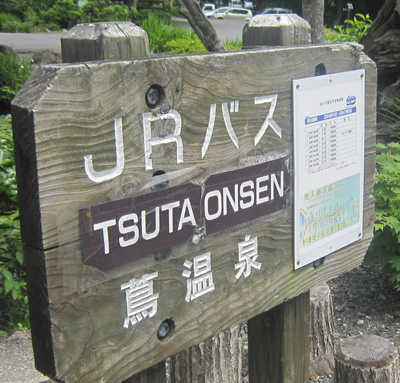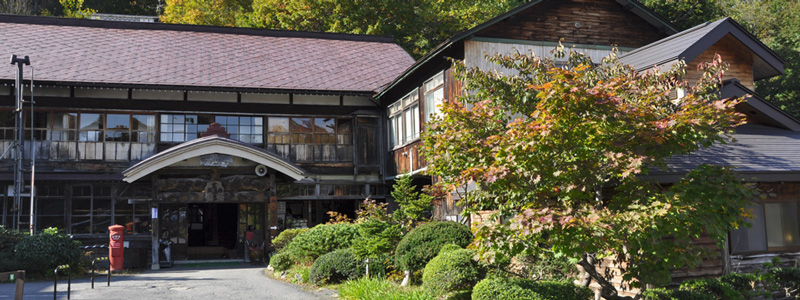About This Print
From Senpan's fourth set of prints picturing Japanese onsens. This print depicts the bus, or auto, stop outside of Tsuda onsen with the sign reading 國鉄自動車 ったおんせん. [National Railway bus stop or auto stop (in Kanji), Tsuda onsen (in hiragana)].The spa-goers stand, looking perplexed, at the sign.
Tsuda onsen today
About the Series Hot Spring Notes
One of his most famous series of prints, Woodblock Prints, Hot Spring Notes (Hanga yokusen fu), depicts various hot springs around Japan. It was published in five volumes of twenty prints each, with each print having an accompanying commentary sheet (see example below), over an 18 year period, starting in 1941 when Maekawa was evacuated to Okayama in southwest Honshu and ending in 1959.
Merritt states that most of the prints were started during the war but could not be published until the war was over. She notes that although his countrymen are depicted at one of their favorite pastimes, spa going for rest and relaxation, "the feeling is not joyous," due to Maekawa's use of somber colors.1 The general demeanor of the spa goers is also somber in many of the prints.
However, writing in 1955, Oliver Statler found Senpan's spa prints "some of his pleasantest prints" and praised Senpan's "connoisseur's selection from the country's hundreds of hot spring resorts."2
1 Modern Japanese Woodblock Prints - The Early Years, Helen Merritt, University of Hawaii Press, 1998, p. 221.
2 "Modern Japanese Creative Prints," Oliver Statler, appearing in Monumenta Nipponica, Vol. 11, No. 2 (July, 1955), Sophia University, p. 27.
A Listing of All the Prints in the Five Sets
Source: Guide to Modern Japanese Woodblock Prints: 1900-1975, Helen Merritt, University of Hawaii Press, 1992, p. 253-255. Photos of volume covers and selected pages from the website https://blog.bunsei.co.jp/2010/09/07/%E7%89%88%E7%94%BB%E9%9B%86%E3%83%BB%E6%B5%B4%E6%B3%89%E8%AD%9C-%E5%89%8D%E5%B7%9D%E5%8D%83%E5%B8%86/
Woodblock Prints, Hot Spring Notes (版画 浴泉譜 Hanga yokusen fu), 1941 by Shimo Tarō of Aoi Shobō. This, the first of a series, contains 20 prints (each about 21 x 21 cm) of different spas and large bathing pools. Sekino Jun'ichirō, who was working for Shimo Tarō at the time, carved some of the color blocks in Maekawa's style because Maekawa fell ill shortly before the scheduled publication date.
| edition size 150 |
More Woodblock Prints, Hot Spring Notes (続版画 浴泉譜 Zoku hanga yokusen fu), 1944. This second album of Yokusen fu was self-published probably because of wartime shortages. Note that only 40 copies of this volume were made.
| edition size 100 |
More and More Woodblock Prints, Hot Spring Notes (続続版画 浴泉譜 Zoku zoku hanga yokusen fu), 1952. This set and the two following bear the imprint of Nihon Aishokai, the name of Shimo Tarō's company after he moved to Okayama prefecture.
|
More, More, and More Woodblock Prints, Hot Spring Notes (続続続版画 浴泉譜 Zoku, zoku, zoku yokusen fu), 1956, published by Nihon Aishokai.
|
More, More, More, and More Woodblock Prints, Hot Spring Notes (続続続続版画 浴泉譜 Zoku, zoku, zoku, zoku hanga yokusen fu), 1959, published by Nihon Aishokai.
|
Print Details
| IHL Catalog | #1159 |
| Title/Description | Tsuta Onsen 蔦温泉 つたおんせん [title as printed on adjoining sheet] |
| Series | More, More and More Hot Spring Notes (続 続 続 浴泉譜 Zoku, zoku, zoku yokusen fu) |
| Artist | Maekawa Senpan (1888-1960) |
| Signature | not signed (None of the prints in this series are signed or sealed.) |
| Seal | not sealed |
| Publication Date | 1956 |
| Publisher | Nihon Aishokai 日本愛書会 Note: Nihon Aishokai was owned by Shimo Tarō. The firm's original name was Aoi Shobō アオイ書房 and it was renamed Nihon Aishokai after moving to Okayama during WWII. |
| Impression | excellent |
| Colors | excellent |
| Condition | excellent |
| Miscellaneous | |
| Genre | sosaku hanga (creative prints) |
| Format | |
| H x W Paper | 15 3/8 x 11 1/2 in. (39.1 x 29.2 cm ) |
| H x W Image | 8 1/4 x 8 5/16 in. (21 x 21.1 cm) |
| Reference Literature | Guide to Modern Japanese Woodblock Prints: 1900-1975, Helen Merritt, University of Hawaii Press, 1992, p. 253-255. |
| Collections This Print |
2/9/2019
11/30/2018




